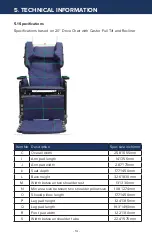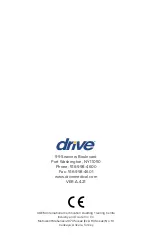
- 9 -
2. SAFETY REQUIREMENTS
2.8 Maintenance
T
he maintenance on a DRIVE chair will vary with the amount of use and the
condition of the resident using the chair.
I
n regular use, after the initial inspection and functional testing, the chair
should be inspected and tested bimonthly. We recommend visually
inspecting for signs of wear, damage, loose or missing fasteners, and other
safety concerns. Periodic testing of chair functions is also necessary. If a
breakage, defect, or operational problem is detected, the chair must be
successfully repaired, inspected and tested for function before it is returned
to service.
T
he chair should be inspected and tested as often as each use if the chair
is used by:
1
. Aggressive or agitated residents.
2. Residents who have involuntary movements.
3. A facility with irregular or sloped surfaces.
4. Any unauthorized person.
D
o not use lubricants that contain solvents. Solvents may compromise any
rubber components on the chair. If necessary, white food grade grease or
lubricant can be used on any sliding components.
2.9 Resident Specific Instructions
T
he primary caregiver responsible for the specific resident’s seating shall
add additional instructions necessary for the safe and effective use of
the chair based on their professional experience and knowledge of the
resident’s specific conditions and requirements. DRIVE representatives are
not professional caregivers and will not know the specific requirements of
the individual using the chair. DRIVE relies on the knowledge, experience,
and judgment of the resident’s professional caregiver to ensure the specific
resident’s safety and comfort needs are satisfied while using the chair.
These instructions form an essential part of the Safety Requirements for
using the chair and must be made available to all caregivers.






































